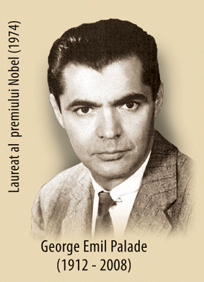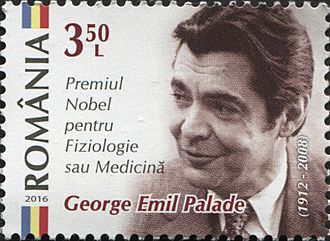George Emil Palade facts for kids
Quick facts for kids
George Palade
|
|
|---|---|
 |
|
| Born |
George Emil Palade
November 19, 1912 |
| Died | October 8, 2008 (aged 95) Del Mar, California, U.S.
|
| Nationality | Romanian |
| Alma mater | Carol Davila School of Medicine |
| Known for | |
| Spouse(s) |
|
| Awards |
|
| Scientific career | |
| Fields | Cell biology |
| Institutions | |
| Notable students | Günter Blobel |
George Emil Palade (November 19, 1912 – October 7, 2008) was a famous Romanian cell biologist. He is often called "the most important cell biologist ever."
In 1974, he won the Nobel Prize with Albert Claude and Christian de Duve. They won for their new ways of using electron microscopes and for a method called cell fractionation. These methods helped create modern cell biology. His most famous discovery was finding the ribosomes in the endoplasmic reticulum in 1955.
Palade also received the U.S. National Medal of Science in 1986. This was for his "pioneering discoveries" of many important structures inside living cells. He was elected to the U.S. National Academy of Sciences in 1961. He also became an Honorary Fellow of the Royal Microscopical Society in 1968. In 1984, he became a Foreign Member of the Royal Society.
Contents
Early Life and Education
George Emil Palade was born on November 19, 1912, in Iași, Romania. His father was a philosophy professor. His mother was a high school teacher.
Palade earned his medical degree in 1940. He studied at the Carol Davila School of Medicine in Bucharest.
Career and Discoveries
Palade taught at Carol Davila University until 1946. Then, he moved to the United States for more research. He worked with Robert Chambers at New York University. There, he met Professor Albert Claude. Later, he joined Claude at the Rockefeller Institute for Medical Research.
In 1952, Palade became a citizen of the United States. He worked at the Rockefeller Institute from 1958 to 1973. He was also a professor at Yale University Medical School from 1973 to 1990. After that, he taught at the University of California, San Diego from 1990 until 2008.
In 1970, he won the Louisa Gross Horwitz Prize from Columbia University. He shared this award with Renato Dulbecco. They were honored for their discoveries about how cells are organized. These findings were very important for cell biology.
Palade gave his Nobel lecture on December 12, 1974. It was titled "Intracellular Aspects of the Process of Protein Secretion." This lecture was published in 1992.
In 1981, Palade helped start the World Cultural Council. In 1985, he became the first editor of the Annual Review of Cell and Developmental Biology. He was also elected an Honorary Member of the American-Romanian Academy of Arts and Sciences in 1988.
Palade was the first head of the Cell Biology Department at Yale University. Today, the top position in Cell Biology at Yale is called the "George Palade Professorship."
Studying Cell Structures
At the Rockefeller Institute, Palade used electron microscopy. This allowed him to study the tiny parts inside cells. He looked at ribosomes, mitochondria, chloroplasts, and the Golgi apparatus.
His most important discovery involved a method called pulse-chase analysis. Using this, Palade and his team confirmed an idea that already existed. They showed that a special path exists for proteins to move within a cell. They also proved that the Rough ER and the Golgi apparatus work together in this process.
He also studied Weibel-Palade bodies. These are tiny storage parts found in blood vessel linings. He described them with the Swiss scientist Ewald R. Weibel.
Ribosome Discovery
George Emil Palade discovered ribosomes. Years later, in 2009, the Nobel Prize in Chemistry was given to Venkatraman Ramakrishnan, Thomas A. Steitz, and Ada E. Yonath. They won for their detailed studies of the structure and function of the ribosome.
Personal Life
Palade's wife, Marilyn Farquhar, was also a cell biologist. She worked at the University of California, San Diego.
See also
In Spanish: George Palade para niños


